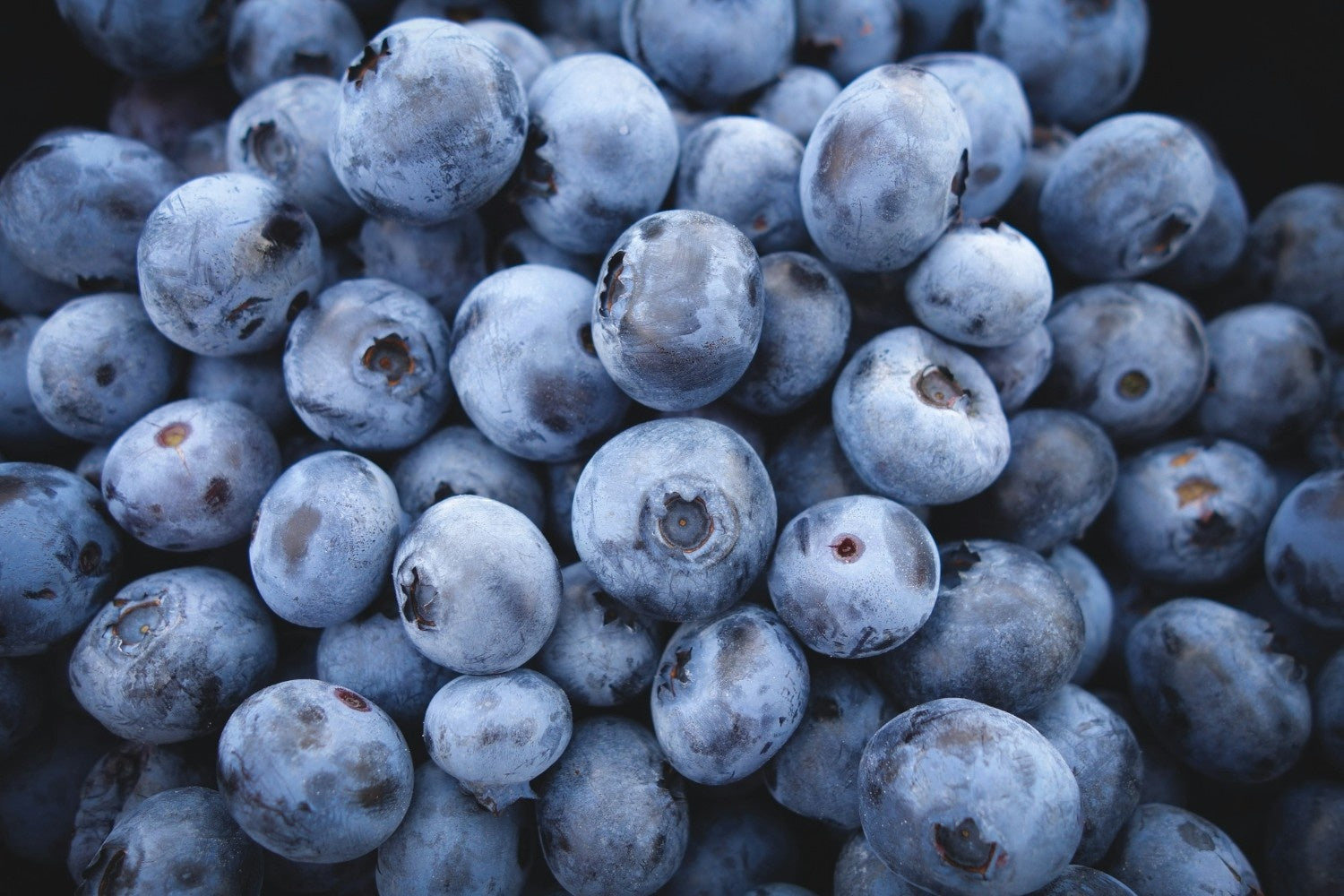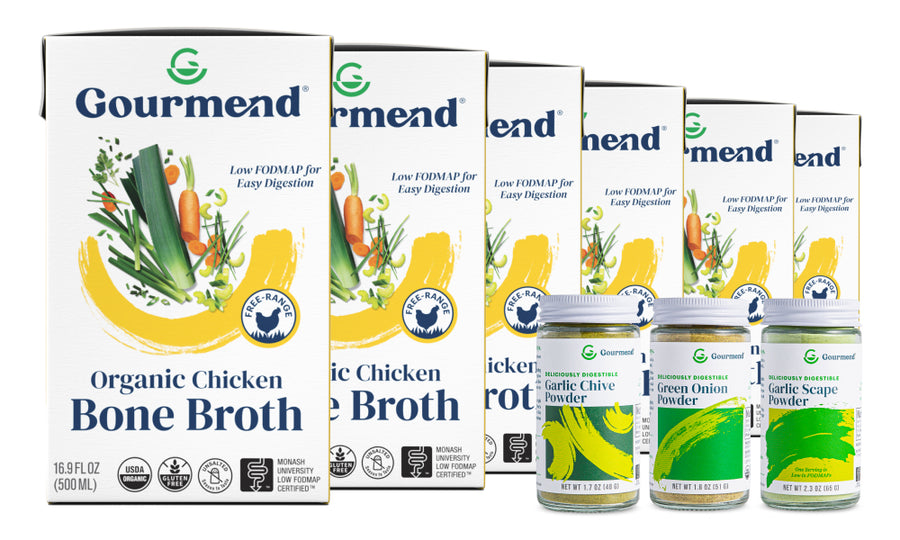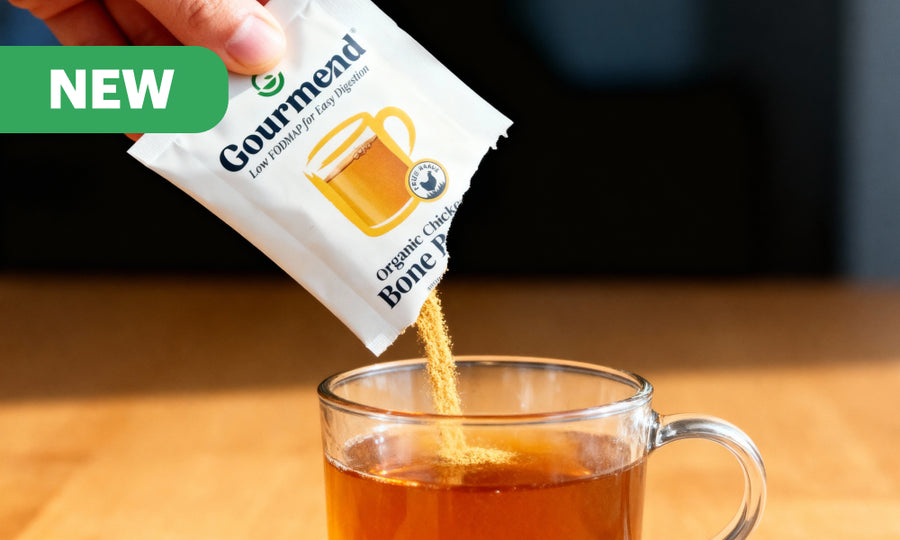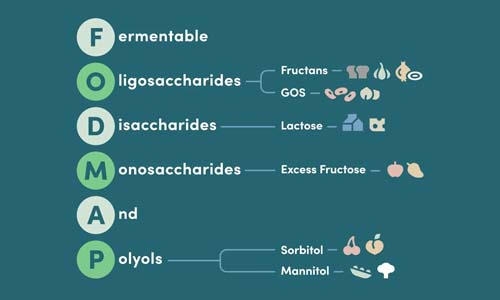Are Blueberries Low FODMAP? Your Complete Guide

If you're navigating the low FODMAP diet, you've probably found yourself scrutinizing every ingredient—including those seemingly innocent berries in your morning smoothie. The good news? Blueberries can absolutely be part of your gut-friendly eating plan when you know the right portion sizes. For a deeper dive into FODMAP basics and more fruit options, check out our FODMAP blog.
Key Takeaways
- Blueberries are low FODMAP at a serving size of 1 cup (150g or about 20-40 berries) according to Monash University research.
- Consuming blueberries in the recommended portion makes them a gut-friendly fruit option for people managing IBS.
- Portion control is important when including blueberries in a low FODMAP diet.
- Blueberries can be safely enjoyed in smoothies and other meals while following a low FODMAP eating plan.
Table of Contents
- What Are FODMAPs?
- Are Blueberries Low FODMAP?
- Blueberries and the Low FODMAP Diet—Practical Guidelines
- 7 Ways to Enjoy Blueberries on a Low FODMAP Diet
- Benefits of Including Blueberries in a Low FODMAP Diet
- Common Pitfalls—What to Avoid with Blueberries
- How to Check If Blueberries Are Tolerated—Personalized Approach
- Advanced Blueberry Strategies for Low FODMAP Success
- Beyond Basic Blueberry Consumption
- Conclusion: Blueberries and Low FODMAP Diet Success
The low FODMAP diet helps millions of people worldwide manage digestive symptoms like bloating, gas, and stomach pain by temporarily reducing certain fermentable carbohydrates. With two-thirds of Americans experiencing digestive issues and nearly 1 billion people living with IBS globally, understanding which fruits support comfortable digestion has never been more important. For more on low FODMAP-friendly recipes, visit our low FODMAP recipes blog.
We're here to give you the complete picture on blueberries and FODMAPs—from serving sizes to creative ways to enjoy them without triggering symptoms.
What Are FODMAPs?
Definition and Overview
FODMAPs stands for Fermentable Oligosaccharides, Disaccharides, Monosaccharides, and Polyols—essentially, specific types of carbohydrates that can ferment in your gut. When these sugars aren't properly absorbed in the small intestine, they travel to the large intestine where gut bacteria ferment them, potentially causing gas, bloating, and other uncomfortable symptoms. For a scientific overview, see this external resource on FODMAPs and digestive health.
Key Point: FODMAPs aren't inherently "bad"—they're simply harder for some people to digest, particularly those with IBS or sensitive stomachs.
Why Certain Fruits Are Problematic
Many fruits contain natural sugars like fructose, sorbitol, and other polyols that fall into the FODMAP category. High FODMAP fruits can trigger digestive distress because these sugars draw water into the intestines and ferment when they reach the colon.
However, not all fruits are created equal. The FODMAP content varies significantly between different fruits, and portion size plays a crucial role in determining whether a fruit will cause symptoms. This is exactly why understanding the specifics about blueberries matters so much.
Are Blueberries Low FODMAP?
The Facts According to Latest Research
Based on Monash University's comprehensive FODMAP testing—the gold standard for low FODMAP research—blueberries are indeed low FODMAP at 1 cup (approximately 150g or 20-40 berries) per serving. This is actually great news for anyone following the diet, as it's a more generous portion than many other fruits allow. For further reading, see this external guide on blueberries and FODMAPs.
Recent updates from Monash have been particularly encouraging for blueberry lovers. Previously, the recommended safe portion was much smaller, but updated testing shows you can enjoy a full cup without worry.
FODMAP Content in Blueberries
Blueberries are naturally lower in fructose compared to many other popular fruits, which is why they're generally well-tolerated. The primary FODMAP concern comes from exceeding the recommended serving size—when you eat more than 1 cup, the FODMAP load increases and may trigger symptoms.
Expert Tip: The form of blueberries matters too. Fresh and frozen (unsweetened) blueberries follow the same portion guidelines, but processed forms like blueberry pie, jam, or juice often concentrate the sugars and exceed safe FODMAP limits.
It's worth noting that individual tolerance can vary. While the 1-cup guideline works for most people, some may find they can tolerate slightly more or need to stick to smaller portions during the initial elimination phase of the low FODMAP diet.
Blueberries and the Low FODMAP Diet—Practical Guidelines
Recommended Serving Size
The magic number is 1 cup (150g or about 20-40 berries, depending on size). This portion has been tested and confirmed as low FODMAP, meaning it shouldn't trigger digestive symptoms for most people following the diet.
At a Glance - Blueberry Serving Size:
- 1 cup fresh blueberries (150g)
- Approximately 20-40 individual berries
- Same guidelines apply to unsweetened frozen blueberries
- Space servings 3-4 hours apart to avoid FODMAP stacking
Tips for Measuring Blueberry Portions
Portion control is essential when following a low FODMAP diet. Here's how to nail your blueberry measurements:
A kitchen scale is your most accurate tool—150g is the target weight for fresh blueberries. If you don't have a scale, use visual cues: one large handful or about what fills a standard coffee mug represents roughly the right amount.
Consider This: Blueberry sizes can vary significantly. Larger berries mean fewer per cup, while smaller berries mean more. When in doubt, measuring by weight rather than counting individual berries gives you the most reliable results.
Frequency and FODMAP Stacking
Even with low FODMAP foods, timing matters. FODMAP stacking occurs when you eat multiple low FODMAP foods close together, potentially creating a higher overall FODMAP load that could trigger symptoms.
Space your blueberry servings by 3-4 hours, and be mindful of other FODMAP-containing foods you're eating in the same meal. This approach helps ensure you stay within your individual tolerance threshold throughout the day. For more practical tips and meal inspiration, explore our Learn blog section.
7 Ways to Enjoy Blueberries on a Low FODMAP Diet
At a Glance: These blueberry ideas keep you within the 1-cup serving limit while maximizing flavor and nutrition.
1. Add Fresh Blueberries to Lactose-Free Yogurt
This combination delivers protein, probiotics, and antioxidants in one gut-friendly package. Choose plain lactose-free yogurt and add your measured cup of blueberries for natural sweetness.
- Balanced macronutrients for sustained energy
- Probiotics support digestive health
- Perfect for breakfast or afternoon snack
- Add a drizzle of maple syrup if needed
2. Sprinkle on Oatmeal or Gluten-Free Cereal
Oats are naturally low FODMAP and pair beautifully with blueberries. This combination provides fiber, antioxidants, and complex carbohydrates that support steady blood sugar levels.
Consider This: Stick to traditional rolled oats or certified gluten-free oats. Avoid instant oatmeal packets that often contain high FODMAP ingredients like inulin or dried high FODMAP fruits.
3. Mix into Salads for a Sweet Boost
Blueberries add natural sweetness and vibrant color to green salads. Try them with spinach, walnuts, and lactose-free feta cheese for a restaurant-quality meal at home. For a delicious salad dressing, try our Low FODMAP French Vinaigrette recipe.
Expert Tip: The combination of blueberries with leafy greens creates a perfect balance of sweet and savory while keeping your meal low FODMAP and nutrient-dense.
4. Bake Low FODMAP Blueberry Muffins
Homemade muffins let you control every ingredient. Use certified gluten-free flour blends and distribute your cup of blueberries across the entire batch to ensure each muffin stays within safe limits.
- Control all ingredients and additives
- Portion blueberries appropriately across servings
- Make ahead for busy mornings
- Freeze extras for later
5. Make Homemade Low FODMAP Smoothies
Blend your cup of blueberries with lactose-free milk, a handful of spinach, and a tablespoon of chia seeds. This creates a nutrient-packed drink that's gentle on digestion.
The key to low FODMAP smoothies is measuring your ingredients carefully and avoiding high FODMAP fruits like mangoes or large amounts of banana.
6. Prepare a Blueberry Chia Pudding
Chia seeds are low FODMAP and create a creamy, pudding-like texture when mixed with liquid. Top with your measured blueberries for a satisfying breakfast or dessert.
Consider This: Chia seeds are low FODMAP up to 2 tablespoons per serving. This makes them an excellent base for puddings that support digestive health.
7. Assemble a DIY Low FODMAP Fruit Cup
Combine blueberries with other low FODMAP fruits like strawberries (5 medium), grapes (1 cup), and kiwi (1 medium) for a colorful, vitamin-rich snack.
- Variety of flavors and textures
- High in vitamin C and antioxidants
- Natural hydration from fruit water content
- Perfect for meal prep
Benefits of Including Blueberries in a Low FODMAP Diet

Nutritional Highlights
Blueberries pack impressive nutrition into their small size. One cup provides about 84 calories, 4 grams of fiber, and 24% of your daily vitamin C needs—all while being naturally low in FODMAPs.
Key Nutrition Facts (per 1 cup):
- 84 calories
- 4g fiber
- 24% daily vitamin C
- High in anthocyanins (powerful antioxidants)
- Good source of vitamin K and manganese
The fiber in blueberries supports healthy digestion without overwhelming sensitive stomachs. Unlike some high-fiber foods that can cause gas and bloating, blueberries provide gentle, soluble fiber that most people tolerate well.
Gut Microbiome and Variety
Food diversity plays a crucial role in maintaining a healthy gut microbiome. Even when following a restrictive diet like low FODMAP, including colorful fruits like blueberries helps ensure you're feeding beneficial gut bacteria.
Expert Tip: The antioxidants in blueberries, particularly anthocyanins, may help reduce inflammation in the digestive tract—a welcome benefit for anyone managing IBS symptoms.
Research suggests that the polyphenols in blueberries can positively influence gut bacteria composition, potentially supporting long-term digestive health while you work through the low FODMAP protocol.
Common Pitfalls—What to Avoid with Blueberries
Overeating and Portion Size
The most common mistake is assuming that because blueberries are low FODMAP, you can eat unlimited amounts. Exceeding the 1-cup serving size increases the FODMAP load and may trigger the very symptoms you're trying to avoid.
Consider This: Even low FODMAP foods can cause problems in large quantities. This concept, known as "FODMAP stacking," is why portion control remains essential throughout your low FODMAP journey.
High FODMAP Blueberry Products
Many processed blueberry products concentrate the sugars or add high FODMAP ingredients. Blueberry pie often contains excess fruit plus high FODMAP ingredients like wheat flour. Commercial blueberry muffins typically exceed safe serving sizes and include problematic additives.
- Avoid: Blueberry juice (concentrated sugars)
- Avoid: Dried blueberries (concentrated FODMAPs)
- Avoid: Commercial blueberry jam (high sugar content)
- Avoid: Store-bought blueberry smoothies (unknown portions)
Misreading Serving Recommendations
Combining blueberries with other FODMAP-containing foods in the same meal can lead to stacking effects. For example, eating blueberries with a large banana and some grapes might push your total FODMAP intake over your tolerance threshold.
The solution is spacing out your FODMAP-containing foods throughout the day and being mindful of cumulative intake, not just individual food portions.
The solution is spacing out your FODMAP-containing foods throughout the day and being mindful of cumulative intake, not just individual food portions.
How to Check If Blueberries Are Tolerated—Personalized Approach
Importance of Monitoring Individual Tolerance
Everyone's FODMAP threshold is different. While research shows blueberries are low FODMAP at 1 cup servings, your personal tolerance might be higher or lower depending on your individual digestive sensitivity.
Key Point: The low FODMAP diet is designed to be temporary and personalized. Start with smaller portions of blueberries and gradually increase to find your individual tolerance level.
Keep a food and symptom diary when introducing blueberries. Note the amount consumed, timing, and any digestive symptoms that occur within 2-24 hours. This tracking helps identify your personal sweet spot for blueberry consumption.
Using the Monash University Low FODMAP Diet App
The Monash University Low FODMAP Diet App remains the gold standard for FODMAP information. The app provides regular updates as new foods are tested and serving size recommendations are refined.
Expert Tip: Food testing is ongoing, and serving size recommendations can change. The Monash app ensures you're working with the most current, research-backed information available.
The app also includes helpful features like a food diary, shopping lists, and recipe suggestions that make following the low FODMAP diet more manageable in daily life.
Advanced Blueberry Strategies for Low FODMAP Success
Timing and FODMAP Stacking Prevention
Space your blueberry consumption at least 3-4 hours apart from other FODMAP-containing foods. This prevents the cumulative effect that can trigger symptoms even when individual foods are within safe limits.
Consider This: If you eat blueberries with breakfast, wait until afternoon before consuming other moderate FODMAP foods like small amounts of nuts or seeds.
Combining Blueberries with Gut-Friendly Ingredients
Pair blueberries with foods that support digestion and enhance nutrient absorption. Healthy fats like those in walnuts or chia seeds can help your body absorb the fat-soluble vitamins in blueberries.
- Combine with lactose-free yogurt for probiotics
- Add to oatmeal for soluble fiber
- Mix with spinach for iron and folate
- Pair with nuts for healthy fats and protein
Seasonal Considerations: Fresh vs. Frozen
Both fresh and frozen blueberries maintain their low FODMAP status, but frozen berries offer year-round availability and often better value. Frozen blueberries are picked at peak ripeness and flash-frozen, preserving their nutritional content.
Choose unsweetened frozen blueberries to avoid added sugars that could increase FODMAP content or trigger symptoms through other mechanisms.
Beyond Basic Blueberry Consumption
Blueberries in Meal Prep
Incorporate blueberries into your weekly meal prep routine by washing and portioning them into 1-cup servings. This prevents overconsumption and makes it easy to grab appropriate portions throughout the week.
Meal Prep Tips:
- Wash and portion blueberries into containers
- Pre-make overnight oats with measured blueberries
- Freeze extra berries in 1-cup portions
- Prepare chia pudding cups with blueberry toppings
Blueberries During Different FODMAP Phases
During the elimination phase, stick strictly to the 1-cup serving size. In the reintroduction phase, you might test slightly larger portions to determine your personal tolerance. During the personalization phase, you can incorporate blueberries based on your individual findings. For more inspiration on adapting recipes, try our Low FODMAP Recipe Conversion Tool.
Expert Tip: Use the reintroduction phase to test not just portion sizes, but also different forms of blueberries—fresh versus frozen, raw versus cooked—to understand your complete tolerance profile.
Conclusion: Blueberries and Low FODMAP Diet Success
Blueberries are definitively low FODMAP at 1-cup servings, making them an excellent choice for anyone following this dietary approach. Their impressive nutritional profile, natural sweetness, and versatility in cooking make them a valuable addition to a gut-friendly eating plan.
Key Takeaways:
- Blueberries are low FODMAP up to 1 cup (150g) per serving
- Portion control prevents FODMAP stacking and symptoms
- Both fresh and frozen varieties are suitable
- Individual tolerance may vary—monitor your response
- Avoid processed blueberry products with concentrated sugars
Remember that the low FODMAP diet is a tool for identifying your personal triggers, not a permanent restriction. Work with a qualified healthcare provider to ensure you're meeting your nutritional needs while managing digestive symptoms effectively.
By incorporating blueberries mindfully into your low FODMAP journey, you can enjoy their delicious flavor and health benefits while supporting your digestive comfort. Start with smaller portions, track your response, and adjust based on your individual tolerance for the best results.
Check out our Low Fodmap Bundles
Frequently Asked Questions
How many blueberries can I have on low FODMAP?
On a low FODMAP diet, you can enjoy blueberries in small amounts—about 20 blueberries or 28 grams per serving is considered low FODMAP. Eating more than this can increase the fructose content, which might trigger symptoms in sensitive individuals.
Are blueberries ok for IBS?
Yes, blueberries are generally well tolerated on a low FODMAP diet, making them a good fruit choice for people with IBS. Their fiber and antioxidant content also support gut health, but portion control is key to avoid digestive discomfort.
What is the lowest FODMAP fruit?
Some of the lowest FODMAP fruits include bananas (unripe), strawberries, oranges, and kiwi. These fruits have minimal fermentable carbs and are less likely to cause bloating or gas, making them easier to digest for people with sensitive guts.
What berries are high FODMAP?
Certain berries like blackberries and raspberries are higher in FODMAPs when eaten in larger quantities—over about 30-40 grams per serving. These can cause digestive issues in some people with IBS, so it’s best to monitor portion sizes.
Are blueberries good for digestive issues?
Blueberries can be beneficial for digestive health due to their antioxidants and fiber, which promote a healthy gut environment. When eaten in appropriate amounts, they offer flavor and nutrition without common gut irritants like onion or garlic.
Is coffee low in FODMAP?
Coffee itself is low FODMAP, but it can still irritate sensitive stomachs due to its acidity and caffeine content. If you have IBS, it’s best to enjoy coffee in moderation and without high FODMAP additives like milk or flavored syrups.





